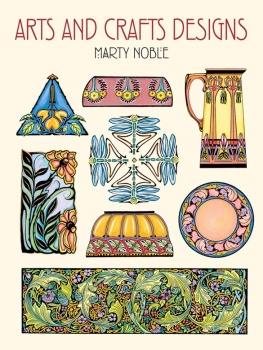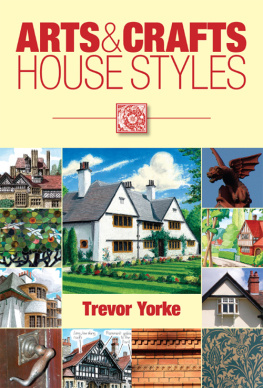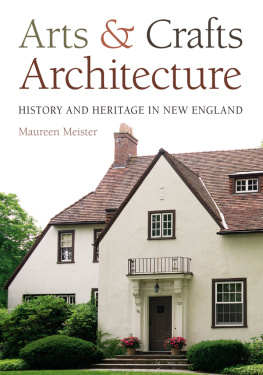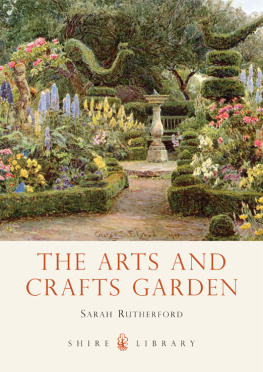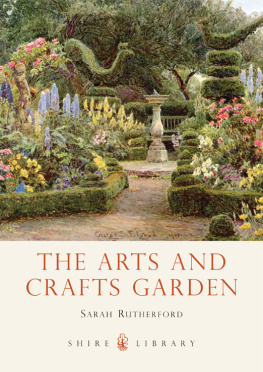Tankard - Gardens of the Arts & Crafts Movement
Here you can read online Tankard - Gardens of the Arts & Crafts Movement full text of the book (entire story) in english for free. Download pdf and epub, get meaning, cover and reviews about this ebook. City: Portland;Oregon, year: 2018, publisher: Workman Publishing;Timber Press, genre: Non-fiction. Description of the work, (preface) as well as reviews are available. Best literature library LitArk.com created for fans of good reading and offers a wide selection of genres:
Romance novel
Science fiction
Adventure
Detective
Science
History
Home and family
Prose
Art
Politics
Computer
Non-fiction
Religion
Business
Children
Humor
Choose a favorite category and find really read worthwhile books. Enjoy immersion in the world of imagination, feel the emotions of the characters or learn something new for yourself, make an fascinating discovery.

- Book:Gardens of the Arts & Crafts Movement
- Author:
- Publisher:Workman Publishing;Timber Press
- Genre:
- Year:2018
- City:Portland;Oregon
- Rating:5 / 5
- Favourites:Add to favourites
- Your mark:
- 100
- 1
- 2
- 3
- 4
- 5
Gardens of the Arts & Crafts Movement: summary, description and annotation
We offer to read an annotation, description, summary or preface (depends on what the author of the book "Gardens of the Arts & Crafts Movement" wrote himself). If you haven't found the necessary information about the book — write in the comments, we will try to find it.
Tankard: author's other books
Who wrote Gardens of the Arts & Crafts Movement? Find out the surname, the name of the author of the book and a list of all author's works by series.
Gardens of the Arts & Crafts Movement — read online for free the complete book (whole text) full work
Below is the text of the book, divided by pages. System saving the place of the last page read, allows you to conveniently read the book "Gardens of the Arts & Crafts Movement" online for free, without having to search again every time where you left off. Put a bookmark, and you can go to the page where you finished reading at any time.
Font size:
Interval:
Bookmark:

Folly Farm, Sulhamstead, Berkshire, England
OF THE
ARTS & CRAFTS
MOVEMENT
TIMBER PRESS PORTLAND, OREGON

C. F. A. Voysey, Bird and Bramble, wallpaper, 1901
IN RECENT YEARS, the Arts and Crafts Movement has been enthusiastically hailed by historians, architects, designers, antique dealers, and a host of entrepreneurs. Its rich legacy of architecture and decorative objects continues to inspire designers and homeowners alike. Museums on both sides of the Atlantic boast collections of the work of the movements star designers, and surviving houses, furniture, textiles, wallpapers, ceramics, metalwork, and books gloriously portray this short-lived, but enlightened, period of design that was cut short by World War I. A romance continues to be spun about this extraordinary era and its iconic buildings, such as William Morriss Red House in England and the Gamble House in America. The fact that the movement was a philosophical approach to design, rather than an identifiable style, is often overlooked.
Though much has been written about the architecture and decorative arts of the period, informed discussions about garden design lag behind. It is a topic worthy of study that goes beyond descriptions of individual gardens and features. The paucity of serious publications on Arts and Crafts garden design is due in part to the fact that gardens are often viewed as isolated entities, dismissed as the sum of their plantings and decorative features, rather than properly understood for their function in an overall scheme. The Arts and Crafts Movement gave the garden a new definition as a harmonious component of the house. It is, in fact, impossible to appreciate garden design of the Arts and Crafts era without understanding the house, or the house without its garden.
This book takes as its theme the inspiration, characteristics, and development of garden design during the Arts and Crafts era. Not surprisingly, William Morris, who stands at the heart of the Arts and Crafts Movement, provided the fundamental philosophy for these gardens. The Arts and Crafts Movement, which focused on raising the standards of architecture and design, owes its greatest debt to Morris. In his own homes and his writings, he demonstrated how gardens were as integral to the home as its architecture and furnishings. Morriss followers provided individualistic and regional stamps to the basic tenets of Morriss philosophy.
Arts and Crafts gardens were not nearly as complex and self-conscious as iconic modern gardens such as Sissinghurst. Instead, they were conceived on a more intimate scale, with well-crafted detailing and a special approach to planting design. They were never an end in themselves, but were intertwined with the house like ivy growing on a wall, blurring the distinctions between indoors and outdoors. Their simple structuring and romantic, medieval-inspired imagery derived from old English manor house gardens. Nothing about them was ostentatious, contrived, or foreign. Hand-built stone walls, hedged enclosures, colorful flower borders, whimsical topiary trees, small structures, sundials, and other traditional ornament made for memorable storybook gardens.
Here youll find a highly personal selection of houses and gardens of the Arts and Crafts era, with an emphasis on the diversity of designers who helped forge a special approach to garden design. Arts and Crafts gardens are presented through the eyes of artists and the words of the designers, gardeners, and critics, drawing on the most influential publications of the era: Country Life magazine, The Studio magazine, Gertrude Jekylls Gardens for Small Country Houses, and Thomas Mawsons The Art and Craft of Garden Making, among others. As one might expect, the thread of Gertrude Jekyll runs through most of the chapters of this book because of her collaboration with several important Arts and Crafts architects, her finely honed planting skills, and her incomparable writings.
Although the Arts and Crafts Movement eventually fell out of favor because of changing aesthetics and altered economic conditions, it left a rich legacy throughout Britain, where its influence was felt in the Garden City Movement and later filtered down to ordinary suburban homes. It also left an unmistakable imprint on American architecture and garden design through the 1920s. Amateur American gardeners responded with a homespun Craftsman style, and architects, designers, and reformers tempered the movements fundamental ideology to the countrys diverse regionalism. In recent years, a renewed interest in traditional building crafts and small enclosed gardens returns the movement to the forefront. In some respects, theres scarcely a contemporary garden designer who does not acknowledge the principles of the Arts and Crafts garden, whether in a simple layout or in the choice of building materials, traditional ornament, and sophisticated planting design.
While a graduate student in art history, I was first introduced to the world of Arts and Crafts architects and designers, notably Morris and C. F. A. Voysey, whose wallpaper designs were the subject of my masters thesis. Having grown up in a house permeated with American Victorian furnishings avidly collected by my parents, I found that the Arts and Crafts era offered a breath of fresh air. Living then in Forest Hills Gardens, an ideal garden suburb designed by Frederick Law Olmsted, Jr., and Grosvenor Atterbury, may have sparked my slumbering awareness of landscape architecture and English-inspired domestic architecture. A seminal visit to Philip Webbs Standen in 1965, while it was still owned by the original family, opened my eyes to another world. Helen Beale welcomed us with homemade scones dripping with butter and cream that had gone sour in the dairy and regaled us with her youthful memories of the dashing architect, heavily enveloped in a large cape, arriving on the building site. Years later, my discovery of Edwin Lutyens and Gertrude Jekyll cemented my addiction to the Arts and Crafts Movement and unwittingly thrust me into the relatively new discipline of garden design history.
This book has grown from a desire to present Arts and Crafts gardens in the broad context of art, architecture, interior design, and decorative arts, in which they need to be appreciated. It was fueled by my personal library of period books and magazines devoted to architecture, garden design, and decorative arts as well as a personal collection of paintings, etchings, and decorative objects by artists and designers of the era. This approach definitely has its limitations, and I leave it to others to write the penultimate studies on American Arts and Crafts gardens, the ramifications of the movement on international garden design, and other related topics.

Kate Greenaway, illustration from Under the Window: Pictures and Rhymes for Children, 1878
IN THE 1870S, ENGLAND BEGAN TO EMERGE from the heavy shroud of Victorian design sensibilities by embracing a new aesthetic that would have ramifications on the design of houses, interiors, and decorative arts until the First World War. The Aesthetic Movement, which centered on the world of James McNeill Whistler and Oscar Wilde, ushered in a new concept in domestic architecture and interior design known as the The House Beautiful. The concept of artistic houses characterized by the lightness of their interiors and decorated with beautiful objects was a welcome relief from the heavy furnishings, dark interiors, and somber palette of the Victorian era. This new aesthetic was especially appealing to the growing middle classes with newfound artistic yearnings.
Next pageFont size:
Interval:
Bookmark:
Similar books «Gardens of the Arts & Crafts Movement»
Look at similar books to Gardens of the Arts & Crafts Movement. We have selected literature similar in name and meaning in the hope of providing readers with more options to find new, interesting, not yet read works.
Discussion, reviews of the book Gardens of the Arts & Crafts Movement and just readers' own opinions. Leave your comments, write what you think about the work, its meaning or the main characters. Specify what exactly you liked and what you didn't like, and why you think so.


